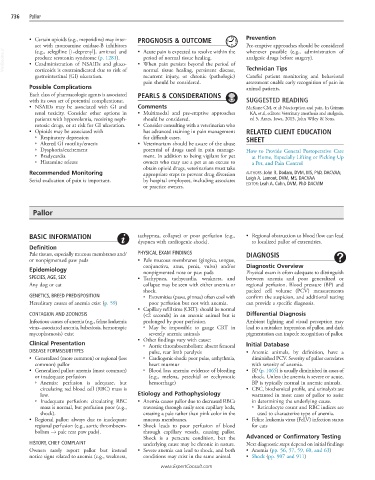Page 1450 - Cote clinical veterinary advisor dogs and cats 4th
P. 1450
736 Pallor
• Certain opioids (e.g., meperidine) may inter- PROGNOSIS & OUTCOME Prevention
act with monoamine oxidase-B inhibitors • Acute pain is expected to resolve within the Pre-emptive approaches should be considered
VetBooks.ir • Coadministration of NSAIDs and gluco- • When pain persists beyond the period of analgesic drugs before surgery).
(e.g., selegiline [L-deprenyl], amitraz) and
whenever possible (e.g., administration of
period of normal tissue healing.
produce serotonin syndrome (p. 1281).
Technician Tips
corticoids is contraindicated due to risk of
recurrent injury, or chronic (pathologic)
gastrointestinal (GI) ulceration. normal tissue healing, persistent disease, Careful patient monitoring and behavioral
pain should be considered. assessment enable early recognition of pain in
Possible Complications animal patients.
Each class of pharmacologic agents is associated PEARLS & CONSIDERATIONS
with its own set of potential complications:. SUGGESTED READING
• NSAIDs may be associated with GI and Comments McKune CM, et al: Nociception and pain. In Grimm
renal toxicity. Consider other options in • Multimodal and pre-emptive approaches KA, et al, editors: Veterinary anesthesia and analgesia,
patients with hypovolemia, receiving neph- should be considered. ed 5, Ames, Iowa, 2015, John Wiley & Sons.
rotoxic drugs, or at risk for GI ulceration. • Consider consulting with a veterinarian who
• Opioids may be associated with has advanced training in pain management RELATED CLIENT EDUCATION
○ Respiratory depression for difficult cases. SHEET
○ Altered GI motility/emesis • Veterinarians should be aware of the abuse
○ Dysphoria/excitement potential of drugs used in pain manage- How to Provide General Postoperative Care
○ Bradycardia ment. In addition to being vigilant for pet at Home, Especially Lifting or Picking Up
○ Histamine release owners who may use a pet as an excuse to a Pet, and Pain Control
obtain opioid drugs, veterinarians must take
Recommended Monitoring appropriate steps to prevent drug diversion AUTHORS: John R. Dodam, DVM, MS, PhD, DACVAA;
Serial evaluation of pain is important. by hospital employees, including associates Leigh A. Lamont, DVM, MS, DACVAA
or practice owners. EDITOR: Leah A. Cohn, DVM, PhD DACVIM
Pallor
BASIC INFORMATION tachypnea, collapse) or poor perfusion (e.g., • Regional obstruction to blood flow can lead
dyspnea with cardiogenic shock). to localized pallor of extremities.
Definition
Pale tissues, especially mucous membranes and/ PHYSICAL EXAM FINDINGS DIAGNOSIS
or nonpigmented paw pads • Pale mucous membranes (gingiva, tongue,
conjunctiva, anus, penis, vulva) and/or Diagnostic Overview
Epidemiology nonpigmented nose or paw pads Physical exam is often adequate to distinguish
SPECIES, AGE, SEX • Tachypnea, tachycardia, weakness, and between anemia and poor generalized or
Any dog or cat collapse may be seen with either anemia or regional perfusion. Blood pressure (BP) and
shock. packed cell volume (PCV) measurements
GENETICS, BREED PREDISPOSITION ○ Extremities (paws, pinnae) often cool with confirm the suspicion, and additional testing
Hereditary causes of anemia exist (p. 59) poor perfusion but not with anemia. can provide a specific diagnosis.
• Capillary refill time (CRT): should be normal
CONTAGION AND ZOONOSIS (<2 seconds) in an anemic animal but is Differential Diagnosis
Infectious causes of anemia (e.g., feline leukemia prolonged by poor perfusion. Ambient lighting and visual perception may
virus–associated anemia, babesiosis, hemotropic ○ May be impossible to gauge CRT in lead to a mistaken impression of pallor, and dark
mycoplasmosis) exist severely anemic animals pigmentation can impede recognition of pallor.
• Other findings vary with cause:
Clinical Presentation ○ Aortic thromboembolism: absent femoral Initial Database
DISEASE FORMS/SUBTYPES pulse, rear limb paralysis • Anemic animals, by definition, have a
• Generalized (more common) or regional (less ○ Cardiogenic shock: poor pulse, arrhythmia, diminished PCV. Severity of pallor correlates
common) pallor heart murmur with severity of anemia.
• Generalized pallor: anemia (most common) ○ Blood loss anemia: evidence of bleeding • BP (p. 1065) is usually diminished in cases of
or inadequate perfusion (e.g., melena, petechial or ecchymotic shock. Unless the anemia is severe or acute,
○ Anemia: perfusion is adequate, but hemorrhage) BP is typically normal in anemic animals.
circulating red blood cell (RBC) mass is • CBC, biochemical profile, and urinalysis are
low. Etiology and Pathophysiology warranted in most cases of pallor to assist
○ Inadequate perfusion: circulating RBC • Anemia causes pallor due to decreased RBCs in determining the underlying cause.
mass is normal, but perfusion poor (e.g., traversing through easily seen capillary beds, ○ Reticulocyte count and RBC indices are
shock). creating a pale rather than pink color in the used to characterize type of anemia.
• Regional pallor: always due to inadequate mucous membranes. • Feline leukemia virus (FeLV) infection status
regional perfusion (e.g., aortic thromboem- • Shock leads to poor perfusion of blood for cats
bolism → pale rear paw pads). through capillary vessels, causing pallor.
Shock is a peracute condition, but the Advanced or Confirmatory Testing
HISTORY, CHIEF COMPLAINT underlying cause may be chronic in nature. Next diagnostic steps depend on initial findings
Owners rarely report pallor but instead • Severe anemia can lead to shock, and both • Anemia (pp. 56, 57, 59, 60, and 63)
notice signs related to anemia (e.g., weakness, conditions may exist in the same animal. • Shock (pp. 907 and 911)
www.ExpertConsult.com

